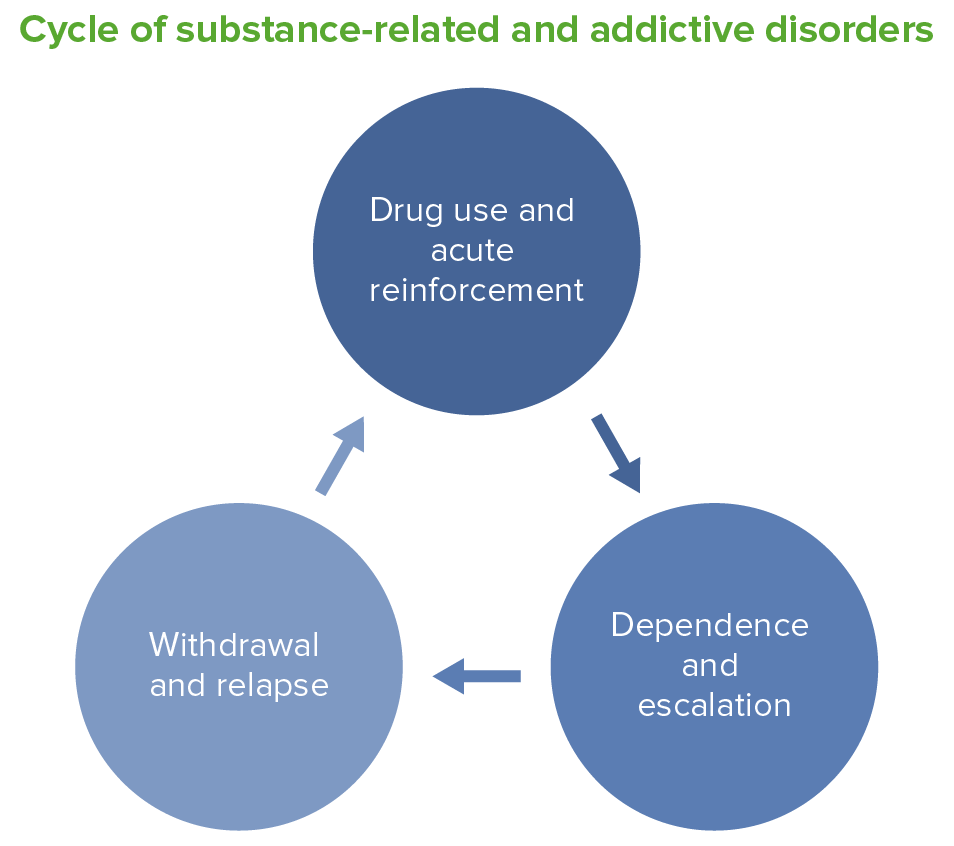Playlist
Show Playlist
Hide Playlist
Substance-related Disorders and Addictive Disorder
-
Slides SubstanceDisordersAlcohol Psychiatry.pdf
-
Download Lecture Overview
00:01 Now, we'll be reviewing substance disorders. 00:04 Substance disorders, basically the essential feature is a cluster of cognitive, behavioral, and physiological symptoms indicating that an individual continues using the substance despite significant disturbance to their lives caused by the substances. Let's talk a little bit about the assessment of a substance use disorder problem. 00:28 You're looking for an individual who has shown a failure to fulfill obligations at work, school, or home. 00:36 In addition, they're using their chosen substance in dangerous situations. 00:40 They have a recurrent substance-related legal problem, and there's continued use despite social or interpersonal problems due to the substance use. 00:52 Now, this is different from substance dependence which is defined as follows: having tolerance, withdrawal, using the substance more than originally intended, persistent desire to cut down or unsuccessful attempts to reduce their intake, an individual who spends a significant amount of time seeking out the substance, decreased social or occupational activities because of time spent using substances instead of engaging with others, and continued use despite physiological problems, this is such as medical illnesses, or physical problems like incurring falls or accidents related to substance use. Let's define tolerance versus withdrawal. 01:41 Tolerance is the need for markedly increased amounts of a substance in order to achieve intoxication or the desired effect and/or diminished effect with the continued use of the same amount of a substance. 01:55 Now, this is different from withdrawal which is actually a condition whereby a characteristic syndrome for a particular substance occurs after diminished use of that substance. 20% of people in the United States have a substance use disorder and men tend to be affected more than women. 02:16 Let me ask you, what are the most commonly misused or problematic substances? Well, here they are, caffeine, alcohol, and nicotine. 02:30 These are actually the most widely misused substances and depression is very common as a co-morbidity in people who misuse substances. 02:42 So what is the most important vitamin you can give to a person who let's say has an alcohol dependence issue and why do you need to give them this vitamin? This is very important to know for your exams. 02:55 You actually need to treat somebody with an alcohol use disorder by giving them thiamine and this vitamin will actually protect that individual from developing a very dangerous syndrome of Wernicke's or Korsakoff's syndrome. 03:10 There are 4 syndromes associated with alcohol withdrawal and because alcohol is such a highly misused substance we're gonna talk about it first. 03:20 So there can be minor withdrawal, withdrawal seizures, alcohol hallucinosis, and delirium tremens.
About the Lecture
The lecture Substance-related Disorders and Addictive Disorder by Helen Farrell, MD is from the course Control Disorders.
Included Quiz Questions
Which of the following is NOT a component of substance dependence?
- Taking post-operative pain medication as prescribed by a physician
- Significant time spent seeking out substance
- Tolerance to the drug
- Withdrawal symptoms seen when the substance is stopped or decreased in amount
- Decreased social or occupational activities because of substance use
Which of the following defines "the need for markedly increased amounts of a substance to achieve intoxication or desired effects and/or diminished effect with the continued use of the same amount of a substance"?
- Tolerance
- Withdrawal
- Dependence
- Substance use disorder
- Sustenance
Which of the following sentences about substance use disorders is FALSE?
- Delusional disorder is the most common co-morbidity seen with substance use disorders.
- Caffeine, alcohol and nicotine are the most commonly misused substances.
- Men are affected more than women.
- About 20% of the population in the United States have substance use disorders.
- Withdrawal can be seen after diminished use of a substance that has been misused.
Which vitamin is given to alcohol dependent people to prevent Wernicke’s or Korsakoff’s syndrome?
- Vitamin B1
- Vitamin B6
- Vitamin B12
- Vitamin C
- Vitamin D3
Customer reviews
5,0 of 5 stars
| 5 Stars |
|
5 |
| 4 Stars |
|
0 |
| 3 Stars |
|
0 |
| 2 Stars |
|
0 |
| 1 Star |
|
0 |




